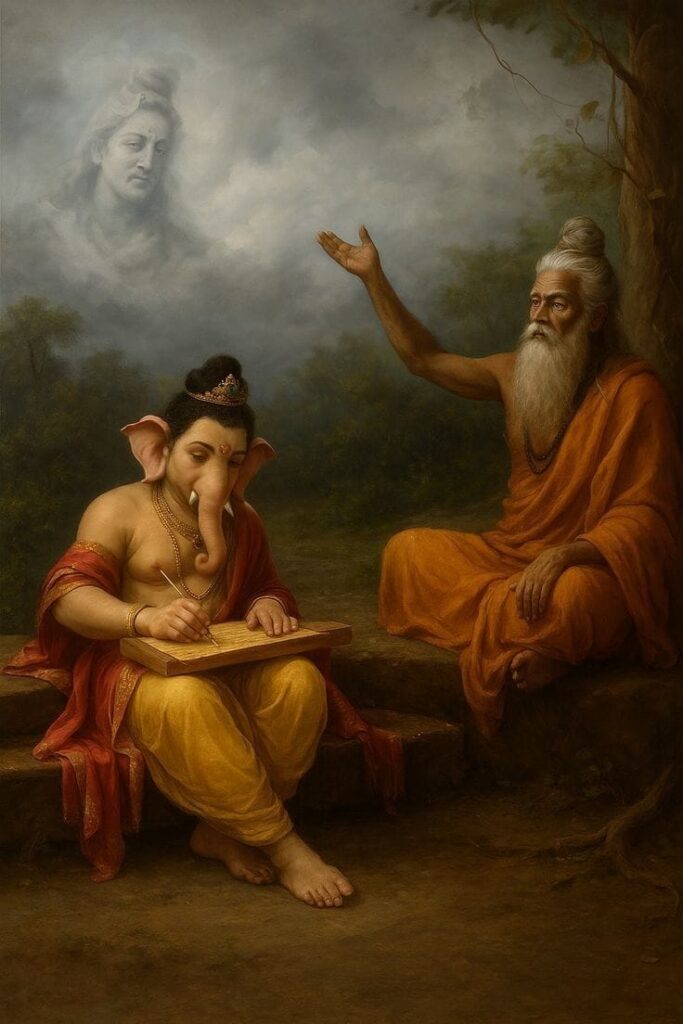
The Story of Maharshi Vyas and Lord Ganesha – The Writing of the Mahabharata
Long ago, in the age of Dvapara Yuga, the great sage Maharshi Vedavyas (Krishna Dvaipayana Vyasa) decided to compose an epic that would be unlike any other. This epic would contain the essence of the Vedas, the wisdom of the Upanishads, the stories of kings, the dharma of life, and the ultimate truth. That great work was destined to be the Mahabharata, the longest and most profound epic in human history.
Vyasa, the son of sage Parashara and Satyavati, was blessed with divine vision. With his deep tapas (penance) and wisdom, he could see past, present, and future as clearly as one sees a fruit in the palm. Yet, though he had the knowledge and vision, he needed someone to write down his words, for the Mahabharata was too vast and grand to be carried by memory alone.
Vyasa Seeks a Scribe
Vyasa prayed to Lord Brahma, the creator, asking,
“O Lord, I wish to compose the story of the Bharata dynasty, which will be a guiding light of dharma for ages to come. But who shall be the scribe to write my words without fail?”
Brahma smiled and said,
“O Vyasa, none among men or gods can keep pace with your divine thoughts, except for Lord Ganesha, the remover of obstacles and the master of knowledge. Invoke Him, and He shall be your scribe.”
Filled with devotion, Vyasa meditated upon Lord Ganesha. The elephant-headed deity, son of Lord Shiva and Goddess Parvati, appeared before him in all radiance. Ganesha’s form shone with wisdom, his large ears ready to listen, his trunk curved gracefully, and his eyes filled with intelligence.
The Agreement Between Vyasa and Ganesha
Vyasa bowed and requested,
“O Lord Ganesha, I seek your aid. Kindly be the scribe of my work, the Mahabharata, so that my vision may be preserved for all humanity.”
Ganesha agreed, but with one condition:
“I shall write only if you dictate without pause. The moment you stop or hesitate, I will cease to write.”
Vyasa, equally wise, smiled and set his own condition:
“So be it, O Lord. But you too must understand every verse before writing it down. If you do not grasp its meaning, you must stop and think.”
Thus, a balance was created. Ganesha would test Vyasa’s speed, and Vyasa would test Ganesha’s understanding. This way, neither could outwit the other, and the work would be completed in harmony.
The Dictation Begins
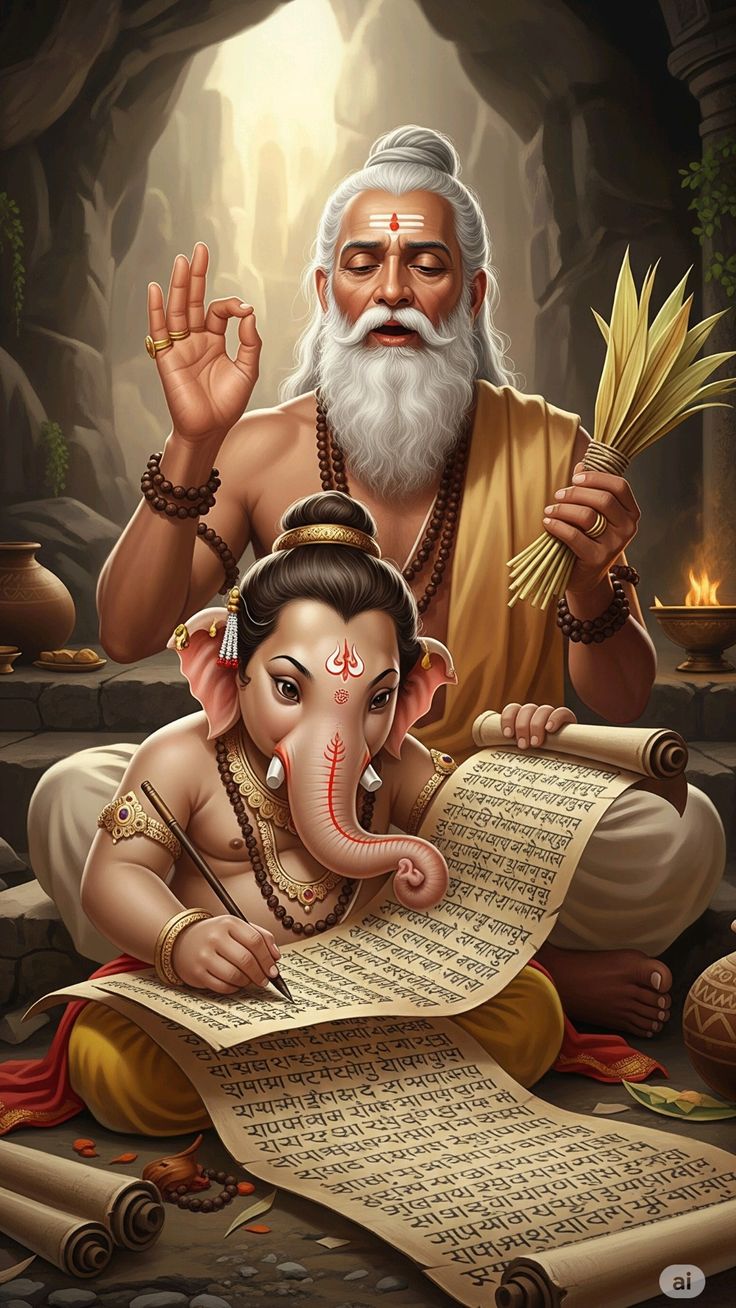
Seated in a quiet cave by the riverbanks, Vyasa began dictating the great story of the Bharatas. Ganesha, seated before him, wrote swiftly with a divine stylus. The sound of his pen scratching upon the surface echoed like thunder in the cave.
Verse after verse flowed from Vyasa’s lips: the birth of kings, the tales of valor, the dilemmas of dharma, the struggles between Kauravas and Pandavas, and the wisdom hidden in every act.
At times, Vyasa deliberately composed complex and profound verses filled with layered meanings. When such shlokas came, Ganesha paused to ponder over their depth, and in those moments, Vyasa rested, gathering his next thoughts. Thus, with cleverness and devotion, the sage kept pace with the divine scribe.
The Breaking of the Tusk
As the writing went on, Ganesha’s stylus broke suddenly, unable to withstand the force and speed of his writing. Not willing to stop even for a moment, the determined Lord Ganesha broke off one of his tusks and used it as a pen. With this sacrifice, He showed that no price is too high when it comes to the pursuit of wisdom.
This is why Ganesha is also called Ekadanta – the One-Tusked Lord.
The Completion of the Mahabharata
Days turned into months. Vyasa poured out one hundred thousand verses, covering every aspect of human life — dharma (righteousness), artha (wealth), kama (desires), and moksha (liberation). It is said that the Mahabharata became so vast that even the Vedas and Upanishads were encapsulated within it.
Finally, when Vyasa concluded his dictation, Ganesha placed down his tusk. The great epic was complete.
Brahma, the gods, and sages praised both Vyasa and Ganesha. The Mahabharata became the fifth Veda, a treasure of wisdom for all time.
Moral and Legacy
The story of Vyasa and Ganesha teaches us:
Great works need both knowledge and discipline.
Even the wisest (Vyasa) and the remover of obstacles (Ganesha) must work together in harmony.
True wisdom demands sacrifice — like Ganesha breaking His tusk.
The Mahabharata is not merely a story of war but a scripture of life, dharma, and truth.
Even today, before starting any great work, people invoke Lord Ganesha, remembering how He wrote the eternal words of Vyasa. And the Mahabharata remains the world’s greatest epic, guiding generations across centuries.
The Story of Sarvajanik Ganesh Utsav – Lokmanya Tilak’s Vision
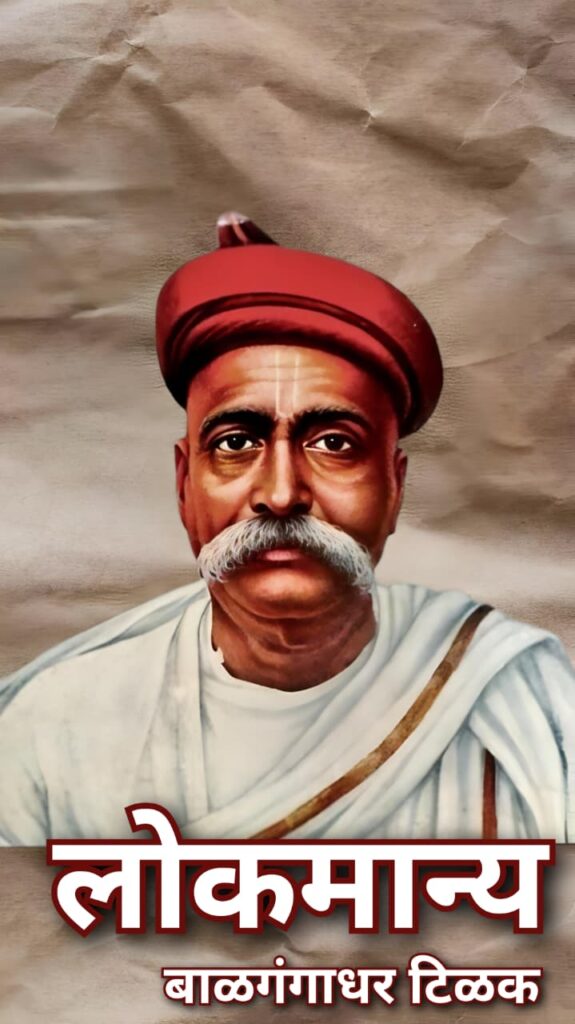
Ganesh Worship in Earlier Times
For centuries, Lord Ganesha was worshipped in Maharashtra and across India as the remover of obstacles, the giver of wisdom, and the harbinger of good fortune. Traditionally, families installed clay idols in their homes during Ganesh Chaturthi, performed puja with devotion, and immersed the idols after the festival.
These celebrations were mostly private and family-centered, not conducted in large public gatherings. The British colonial rulers of India were suspicious of large assemblies and discouraged public festivals, fearing they could lead to uprisings.
India Under British Rule
By the late 19th century, India was under strict British control. Public meetings and gatherings were banned or restricted, especially if they had a political or nationalist flavor. The freedom movement was gaining strength, but common people had little space to come together, share ideas, and unite.
It was during this time that Bal Gangadhar Tilak, one of India’s greatest freedom fighters and social reformers, had a visionary idea.
Tilak’s Inspiration
Tilak noticed that festivals had the power to bring people together, cutting across caste, class, and community. In particular, Ganesh worship was popular among all sections of society. Ganesha, the beloved deity of the masses, could become a symbol of unity and strength.
Tilak thought:
“If Ganesh Chaturthi can be celebrated not just at home, but in open grounds and temples where all people gather, it will unite society. Such unity can later transform into the strength of the freedom movement.”
The First Public Ganesh Festival
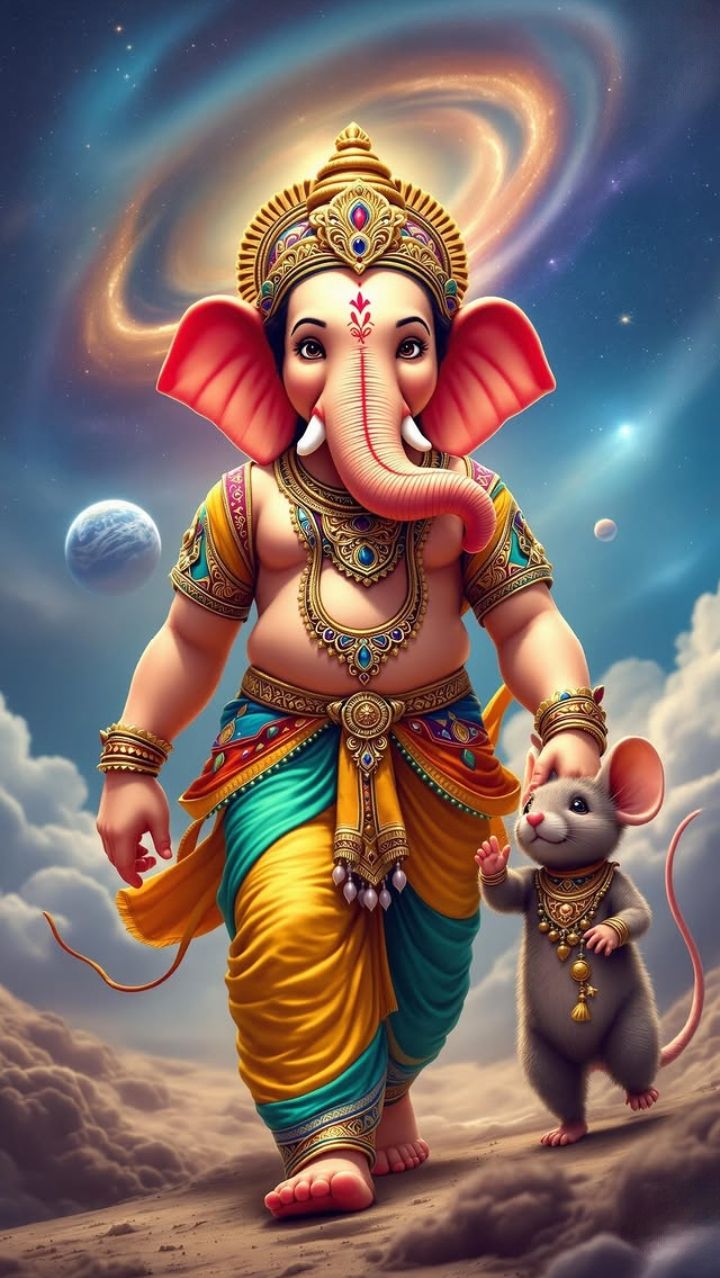
In 1893, Lokmanya Tilak organized the first Sarvajanik (public) Ganesh Utsav in Pune. Instead of limiting Ganesh Chaturthi to private homes, he encouraged communities to install large idols of Lord Ganesha in public pandals. People gathered together to sing bhajans, perform aartis, and listen to speeches.
But these were not only religious gatherings. Along with devotion, Tilak added:
Patriotic songs and plays inspiring love for the motherland.
Lectures on history and freedom, hidden within religious discussions.
Cultural programs that spread unity and awareness.
In this way, the Ganesh festival became both a religious celebration and a social movement.
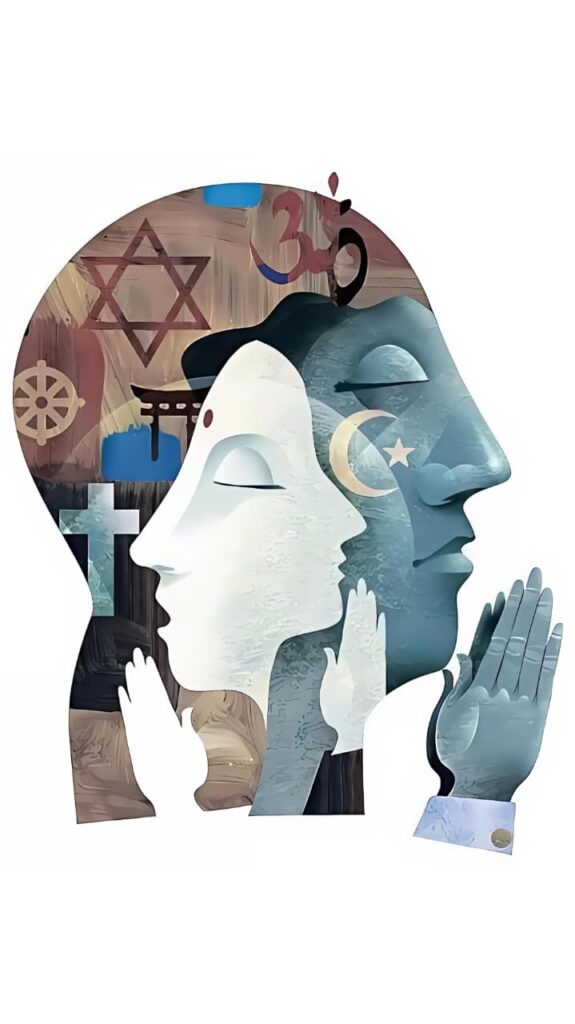
Unity Across Castes and Communities
One of Tilak’s greatest achievements was breaking social barriers. In those times, caste divisions were very strong. Higher castes and lower castes often did not eat or worship together. But under the umbrella of Lord Ganesha, Tilak encouraged all castes and communities to participate together in public celebrations.
This brought about a sense of collective identity as Indians, rather than divisions based on caste or region.
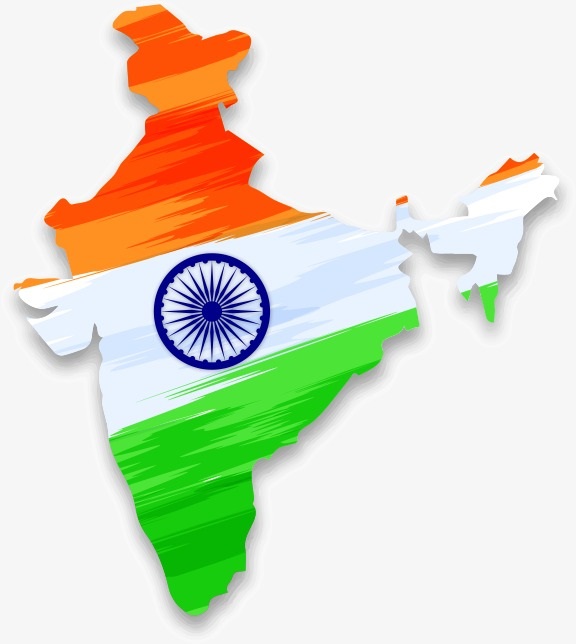
A Cover for Nationalism
The British could not easily ban the Ganesh festival because it was a religious event. Thus, under the cover of devotion, people were able to gather in large numbers without fear of arrest.
Tilak used this opportunity to spread nationalist ideas, inspire youth, and instill pride in India’s heritage. Public Ganesh Utsavs soon spread from Pune to Mumbai and across Maharashtra, eventually becoming popular throughout India.
Growth of the Movement
By the early 1900s, almost every town and village in Maharashtra had its Sarvajanik Ganesh Mandals.
These mandals organized processions, cultural events, debates, and plays with hidden messages of freedom.
The festival became a platform for unity and resistance against British rule.
Legacy
Today, the Sarvajanik Ganesh Utsav is one of the grandest festivals in India, especially in Maharashtra. Millions gather to worship Lord Ganesha in huge pandals, sing aartis, and participate in processions.
Behind the devotion lies the vision of Lokmanya Tilak — a man who understood that true strength comes from unity, and that culture and religion could be powerful tools in the struggle for independence.
Moral of the Story
Lokmanya Tilak transformed a simple household festival into a mass movement. What was once just a family tradition became a symbol of social unity, cultural pride, and political awakening.
Ganesh Utsav reminds us even today that festivals are not only about celebration, but also about coming together as a community and working for a greater cause.
